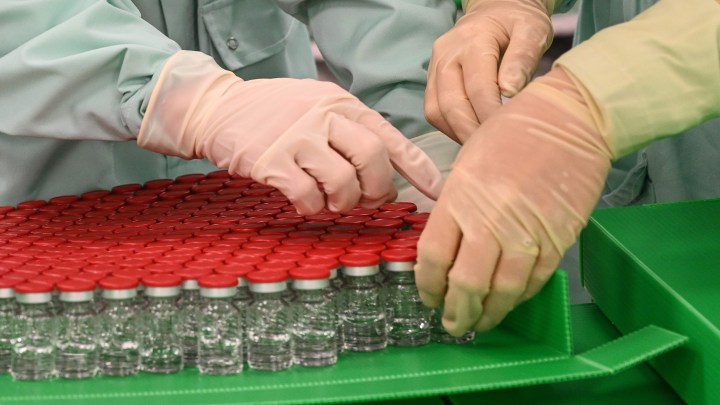
What’s the definition of the “right” COVID-19 vaccine?
What’s the definition of the “right” COVID-19 vaccine?

What requirements should define the “right” COVID-19 vaccine? Many companies, countries and organizations are still figuring that out as they continue to develop and test potential coronavirus vaccines.
The “Marketplace Morning Report” put that question to Dr. Larry Brilliant, a former “rock doc” epidemiologist who helped end smallpox and polio via vaccine programs and who believes the right COVID-19 vaccine must fulfill certain requirements, like ease of use and easy storage, to be as effective as possible.
This is part two of a two-part interview. You can read part one here.
Brilliant: In thinking about what the right vaccine is in dealing with this coronavirus, we only need to look at the contrast between polio eradication and smallpox eradication. The smallpox vaccine, which we had for 200 years before we had a successful campaign, it required one shot. It was effective in almost every case. It had a very low rate of side effects and it could be delivered with a bifurcated needle using a freeze-dried vaccine that was freeze-dried like coffee and was then reconstituted. So a villager, a farmer, a homeless person could vaccinate the people around them. Fast-forward to polio, also an effective vaccine given with a drop, which is better than any kind of an injection. However, there are children in Pakistan today, the last country that has a lot of polio, who have to be vaccinated 20 times in order for that vaccine to be effective.
Brilliant: So thinking about coronavirus, the vaccine that we want is one that can be used in the most remote places by anybody. You don’t want it to have to have a vaccine injector gun that needs electricity. You want it to have a very long period of immunity, not just because that’s what you want for the person, but you want to be able to have a program that lasts three or four years that doesn’t have to require visiting somebody again. So a vaccine that requires two doses a month apart and a booster a year later, that doesn’t qualify as a good vaccine. And most of the early candidate vaccines do require that. And then probably most important, you can’t require a cold chain, especially storage at minus 80 degrees as two of the leading candidates do and hope to get into the villages in the remote corner of Zimbabwe or Bihar. You need to have a vaccine which is easily transportable. So you put all those things together. Those begin to be a new set of criteria for a vaccine that will help us throw this virus into the dustbin of history.

Brancaccio: Let me understand this better. This cold chain. You’re saying that some of the early vaccine candidates that are showing promise have to be kept not just in a fridge, but colder than that until they get to the place where someone’s going to get a shot?
Brilliant: That’s right. Many of the vaccines, and I’m not going to talk about the manufacturers, but many of the techniques that are being used are novel. We’ve never had an mRNA vaccine. Some of the other combinations we’ve never had before and they are inherently unstable. And they will destroy themselves in a way at higher temperatures. So they have to be stored at very cold temperatures. Just imagine the kind of refrigeration vehicle that you’d need to have in order to keep quantities of vaccine cold. So it adds a level of complexity that almost disqualifies it as being a vaccine that will allow us to work in 220 countries and meet the needs of getting to the most remote places.
Brancaccio: There’s that expression, “the perfect is the enemy of the good.” Will it help that what you regard as a safe but imperfect vaccine — does it help if that does get out into people in the early phases of our vaccine response until we can get the more sophisticated vaccines online?
Brilliant: Absolutely. I don’t want to disqualify the early vaccines because they’re not perfect. No, we need to vaccinate 6 billion people. The highest percentage of them will be vaccinated with imperfect vaccines. And I don’t mean unsafe, I just mean that they will have perhaps a lower efficacy. And we’re glad to have them. This virus will continue to ping-pong back and forth until every person who needs to be vaccinated has been vaccinated in the most remote corners of the planet. And to reach those and to do it effectively in 220 countries will require a vaccine — that they don’t require multiple doses, that they’re easy to transport, that they can be delivered either by an untrained person or as part of a big program. And these characteristics are not the ones that will make a vaccine reach the market sooner. But there’s nothing unusual about this, David. Most people listening to this got the early shingles vaccine, and we’re very happy to get it. It provided a great deal of immunity but not enough. And when the newer one, the more modern one, came up it gave a higher degree of immunity, they got that too. Such is the nature of innovation.
There’s a lot happening in the world. Through it all, Marketplace is here for you.
You rely on Marketplace to break down the world’s events and tell you how it affects you in a fact-based, approachable way. We rely on your financial support to keep making that possible.
Your donation today powers the independent journalism that you rely on. For just $5/month, you can help sustain Marketplace so we can keep reporting on the things that matter to you.












